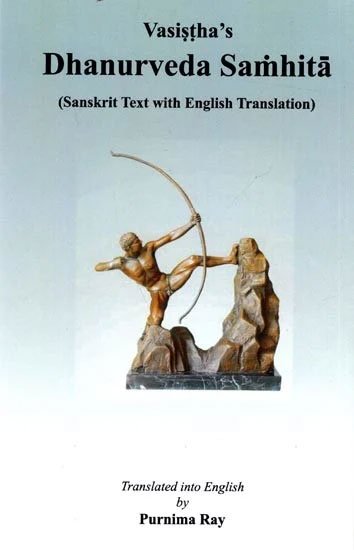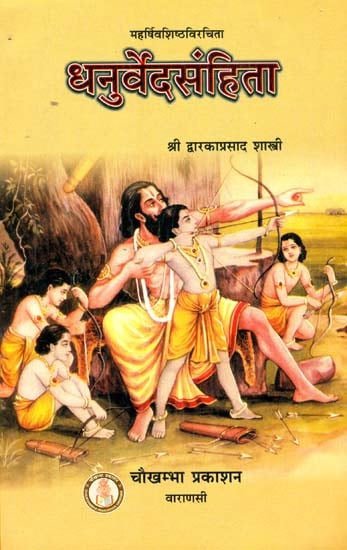Dhanurveda Samhita [sanskrit]
3,015 words
The Sanskrit text of the Dhanurveda-samhita attributed to Vasishtha. Dhanur Veda is a type of ancient India science whose roots date to the 2nd millenium BCE. It is counted among the Upavedas literature. This specific version of the Dhanurveda contains roughly 240 sections of Sanskrit text.
Verse 1.157
लक्ष्ये बिन्दुं न्यसेच्छुभ्रं शुभ्रबन्धूकपुष्पवत् ।
हन्ति तं बिन्दुकं यस्तु चित्रयोधा स उच्यते ॥ १५७ ॥
lakṣye binduṃ nyasecchubhraṃ śubhrabandhūkapuṣpavat |
hanti taṃ bindukaṃ yastu citrayodhā sa ucyate || 157 ||
Note! The following is not a translation of the above verse, but merely an arbitrary extract of the English text.
Place a white dot on the target, like a white bandhuka flower. The one who kills that drop of water is called Citrayodha.
English translation by Hardayalu Swami (2001) Buy now!
Glossary of Sanskrit terms
Note: This extracts Sanskrit terms and links to English definitions from the glossary, based on an experimental segmentation of verse (1.157). Some terms could be superfluous while some might not be mentioned. Click on the word to show English definitions.
Lakshya, Bindu, Shubhra, Bandhuka, Pushpavat, Binduka, Yah, Citra, Udha, Sah, Ucyat,
Analysis of Sanskrit grammar
Note: this is an experimental feature and only shows the first possible analysis of the Sanskrit text (Verse 1.157). If the system was successful in segmenting the sentence, you will see of which words it is made up of, generally consisting of Nouns, Pronouns, Verbs, Participles and Indeclinables. Click on the link to show all possible derivations of the word.
- Line 1: “lakṣye binduṃ nyasecchubhraṃ śubhrabandhūkapuṣpavat ”
- lakṣye -
-
lakṣya (noun, masculine)[locative single]lakṣya (noun, neuter)[nominative dual], [vocative dual], [accusative dual], [locative single]lakṣyā (noun, feminine)[nominative dual], [vocative single], [vocative dual], [accusative dual]√lakṣ -> lakṣya (participle, masculine)[locative single from √lakṣ class 1 verb], [locative single from √lakṣ class 10 verb]√lakṣ -> lakṣya (participle, neuter)[nominative dual from √lakṣ class 1 verb], [vocative dual from √lakṣ class 1 verb], [accusative dual from √lakṣ class 1 verb], [locative single from √lakṣ class 1 verb], [nominative dual from √lakṣ class 10 verb], [vocative dual from √lakṣ class 10 verb], [accusative dual from √lakṣ class 10 verb], [locative single from √lakṣ class 10 verb]√lakṣ -> lakṣyā (participle, feminine)[nominative dual from √lakṣ class 1 verb], [vocative single from √lakṣ class 1 verb], [vocative dual from √lakṣ class 1 verb], [accusative dual from √lakṣ class 1 verb], [nominative dual from √lakṣ class 10 verb], [vocative single from √lakṣ class 10 verb], [vocative dual from √lakṣ class 10 verb], [accusative dual from √lakṣ class 10 verb]√lakṣ (verb class 1)[present passive first single]√lakṣ (verb class 10)[present passive first single]
- bindum -
-
bindu (noun, masculine)[accusative single]
- Cannot analyse nyasecchubhram*śu
- śubhra -
-
śubhra (noun, masculine)[compound], [vocative single]śubhra (noun, neuter)[compound], [vocative single]
- bandhūka -
-
bandhūka (noun, masculine)[compound], [vocative single]
- puṣpavat -
-
puṣpavat (noun, masculine)[compound]puṣpavat (noun, neuter)[nominative single], [vocative single], [accusative single]
- Line 2: “hanti taṃ bindukaṃ yastu citrayodhā sa ucyate ”
- hanti -
-
hanti (noun, feminine)[compound], [adverb]√han (verb class 2)[present active third single]
- tam -
-
ta (noun, masculine)[adverb], [accusative single]ta (noun, neuter)[adverb], [nominative single], [accusative single]tā (noun, feminine)[adverb]tan (noun, masculine)[adverb]sa (noun, masculine)[accusative single]
- bindukam -
-
binduka (noun, masculine)[adverb], [accusative single]bindukā (noun, feminine)[adverb]
- yas -
-
yaḥ (indeclinable relative)[indeclinable relative]ya (noun, masculine)[nominative single]yaḥ (pronoun, masculine)[nominative single]
- tu -
-
tu (indeclinable particle)[indeclinable particle]
- citrayo -
-
citrā (noun, feminine)[instrumental single]
- udhā -
-
udhā (noun, feminine)[nominative single]
- sa* -
-
saḥ (indeclinable correlative)[indeclinable correlative]sa (noun, masculine)[nominative single]
- ucyate -
-
√uc -> ucyat (participle, masculine)[dative single from √uc class 4 verb]√uc -> ucyat (participle, neuter)[dative single from √uc class 4 verb]√vac (verb class 2)[present passive third single]√vac (verb class 3)[present passive third single]
Other editions:
Also see the following editions of the Sanskrit text or (alternative) English translations of the Verse 1.157
Dhanurveda Samhita (धनुर्वेदसंहिता)
by Hardayalu Swami (2001)
Publisher: Khemraj Shrikrishnadass
Buy now!
Vasistha’s Dhanurveda Samhita
by Purnima Ray (2023)
Publisher: Khemraj Shrikrishnadas; ISBN-10: 818670289X; ISBN-13: 9788186702895; 88 pages including 18 illustrations;
Buy now!
Dhanurveda Samhita (धनुर्वेदसंहिता) (संस्कृत एवं हिंदी अनुवाद)
by Shri Dwarka Prasad Shastri (2007)
Title: Dhanurveda Sanhita (Hindi translation); Publisher: Chaukhambha Prakashan, Varanasi; 84 pages including 11 illustrations; Author: महर्षि वशिष्ठ (Maharshi Vashistha); Foreword by Dr. Chakradhar Bijalwan.
Buy now!![Dhanurveda Samhita [sanskrit] - book cover](/uploads/a/Dhanurveda-Sanskrit.jpg)

